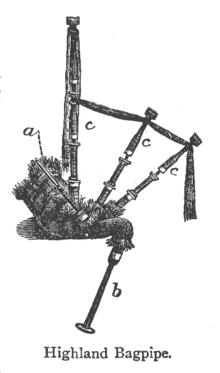
Summary
In mathematics, the bagpipe theorem of Peter Nyikos (1984) describes the structure of the connected (but possibly non-paracompact) ω-bounded surfaces by showing that they are "bagpipes": the connected sum of a compact "bag" with several "long pipes".

Statement edit
A space is called ω-bounded if the closure of every countable set is compact. For example, the long line and the closed long ray are ω-bounded but not compact. When restricted to a metric space ω-boundedness is equivalent to compactness.
The bagpipe theorem states that every ω-bounded connected surface is the connected sum of a compact connected surface and a finite number of long pipes.
A space P is called a long pipe if there exist subspaces each of which is homeomorphic to such that for we have and the boundary of in is homeomorphic to . The simplest example of a pipe is the product of the circle and the long closed ray , which is an increasing union of copies of the half-open interval , pasted together with the lexicographic ordering. Here, denotes the first uncountable ordinal number, which is the set of all countable ordinals. Another (non-isomorphic) example is given by removing a single point from the "long plane" where is the long line, formed by gluing together two copies of at their endpoints to get a space which is "long at both ends". There are in fact different isomorphism classes of long pipes.
The bagpipe theorem does not describe all surfaces since there are many examples of surfaces that are not ω-bounded, such as the Prüfer manifold.
References edit
- Nyikos, Peter (1984), "The theory of nonmetrizable manifolds", Handbook of set-theoretic topology, Amsterdam: North-Holland, pp. 633–684, MR 0776633


